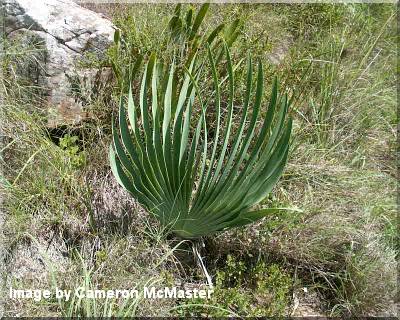

Boophone disticha straight leaf form, The Deeps, East Cape, RSA. 1Feb, 2004.
The Genus Boophone come from Southern Africa. This is widely distributed throughout Southern Africa extending into Topical Africa. Boophone disticha is a poisonous bulb and is used in many rituals by the Africa Bushmen {(Xhosa) (Duncan/DuPleiss, Bulbous Plants of Southern Africa)} due to the many medicinal properties contained within the bulb. Consuming any parts of this bulb can prove fatal to humans and also sheep and cattle.
Boophone is either winter or summer growing. It grows to a very large bulbs with many papery sheaths (or tunicated) at the neck, at or below ground level. The foliage of Boophone disticha can vary from strap like to undulate wavy margins, grey-green in colour and can reach a considerable length. The flower is a large, dense umbrel of many smaller flowers going to make up the whole (bloom) globe. This is typical of Amaryllids from Southern Africa. When the seeds set, most Amaryllids allow their whole flower head to break off and roll along the veldt to distribute their seeds. I marvel at their adaptability to their environment! Seeds can take up to seven years to flower for the genus Boophone, some longer. You can also propagate from offset from certain bulbs, although, some do not produce any offsets at all.
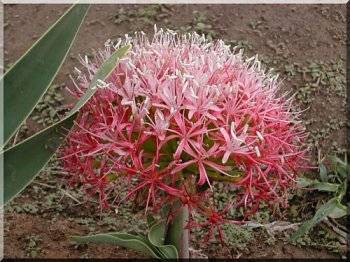
Boophone disticha flowering at Mainly Amaryllids Garden spring 2004.
Cultivation for Boophone requires excellent drainage and a deep sandy medium. Boophone grow a very large root system so be sure to accommodate for these. At 20 inch pot will easily house 3 mature bulbs. In time though, these will need potting-on to a large pot.
Boophone and Crossyne pests are few and a great deal relies on how you cultivate your bulbs. Healthy bulbs mean less pests and disease. I have outbreaks here at our garden of Mealy Bug and Red Spider Mite and these can be hard to contain at times without regular spraying. I have a program for intermittent spraying and I change what I spray so the bugs don't get used to the formulae. Most of us have our recipes for dealing with these problems. If in doubt, try your local Nursery Supplier. They should know what to do.
This has become one of my (many) favourite bulbs to grow.
Enjoy the day and happy gardening,
Dash.
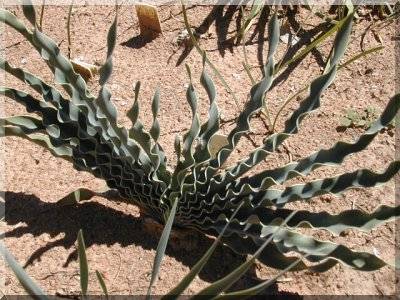
Above and below, two leaf forms of Boophone disticha growing here at Mainly Amaryllids Garden.
So far, I have found 4 distinct leaf types of Boophone disticha.
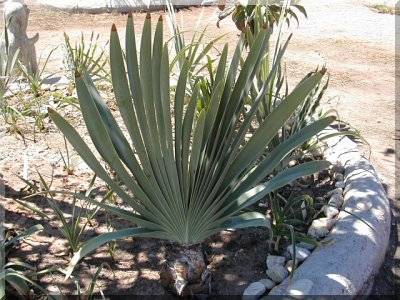
This curious and little known bulb has yet to make its mark in horticulture. Strap like green/grey leaves lay in a cross position prostrate along the ground during the growing season. An amazing bloom, it is fills the surrounding air with an enticing perfume, engaging the onlooker with beautiful deep cerise flowers, which fade to a deep colour as they age.
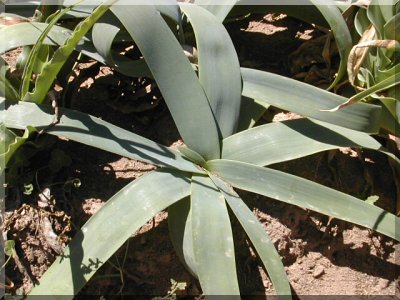
Ammocharis coranica growing at Mainly Amaryllids Garden.
This genus comprises approximately 5 species, three of which occurs in Southern Africa. Ammocharis coranica is the most widespread of this genus and probably the most common in current day horticulture. This is a summer growing bulb that needs a large pot or to be planted into the ground. Ammocharis coranica develops into a large bulb with a hard papery outer sheath covering and have large fleshy roots that persist all year. These bulbs resent disturbance as it takes a year or two to build up the roots and establish themselves again. The amount of roots in most Amaryllidaceae bulbs pertains to whether the bulbs will flower well or not. This is a typical scenario with Amaryllidaceae bulbs.
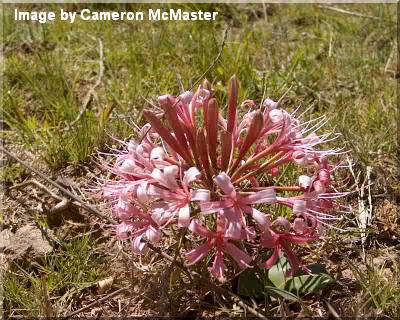
Ammocharis coranica is a summer growing bulb and requires a full sun position in the garden with clay/sandy soils in deep pots. Feeding can be blood and bone (urea free) and wood ash from the fire once during the growing season. As many bulbs have adapted to poor soils, don't be too eager to feed this genus. Ammocharis coranica can live in very poor soils and still do quite well with flowering and setting seeds. In the image below we can see the soil is clay like and has cracks on the surface, indicating a heavy soil. The Amaryllid student will need to duplicate to a certain extent, the same conditions, for success in cultivating bulbous material from the wild.
Seeds usually germinate readily and are pressed into a sandy medium and raised in pots for the first year or so. I am currently trailing sowing straight in to the ground and I am finding this method excellent! Most of the seeds have germinated well. This method will alleviate the need to handle the seedlings from pots to garden bed.
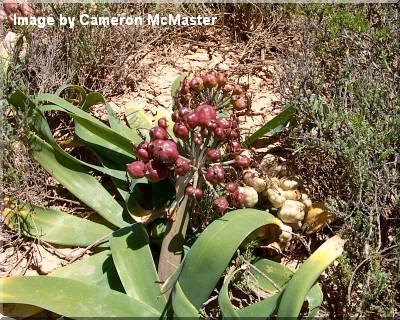
Ammocharis coranica in fruit Aberdene, Eastern Cape, RSA. 6 Feb, 2004.
Ammocharis coranica can handle the frost here in the garden. We get down to -1C. typically each winter and the bulbs do OK. Providing excellent drainage is an important factor when cultivating any Amaryllids. Especially during the dormant months. This exquisite bulb needs to be more recognized as one of the best horticultural subjects to arrive at the market place in many years. Although Ammocharis coranica take 6-8 years to flower from seed, once they are flowering in the garden, you will surely agree to this bulbs potential.
Currently, Mainly Amaryllids Garden has 4 different collections on offer of this bulb. I hope that they impress you s much as they have me!
Please feel free to
![]() contact me if you feel
there is any thing further I can add to the above notes.
contact me if you feel
there is any thing further I can add to the above notes.
Best wishes,
Dash.
-------------------------------------------------------------------------------------
 A
disk of images and cultivation information called 'Wild Bulbs of the Eastern Cape' is available
from Cameron McMaster. This disk is a highly informative and extremely pictorial
collection, captured by Cameron whilst collecting seeds out in the field.
Cameron McMaster is one of South Africa's most noted naturalists, whose
enthusiasm shines through on this information available. His love of the plants
and the surrounding environment resounds through this disk. I consider myself
very lucky to have a friendship with such a dedicated and personable gentleman.
A
disk of images and cultivation information called 'Wild Bulbs of the Eastern Cape' is available
from Cameron McMaster. This disk is a highly informative and extremely pictorial
collection, captured by Cameron whilst collecting seeds out in the field.
Cameron McMaster is one of South Africa's most noted naturalists, whose
enthusiasm shines through on this information available. His love of the plants
and the surrounding environment resounds through this disk. I consider myself
very lucky to have a friendship with such a dedicated and personable gentleman.
![]() Order
Wild Bulbs of the Eastern Cape disk
Order
Wild Bulbs of the Eastern Cape disk ![]() Home
Home